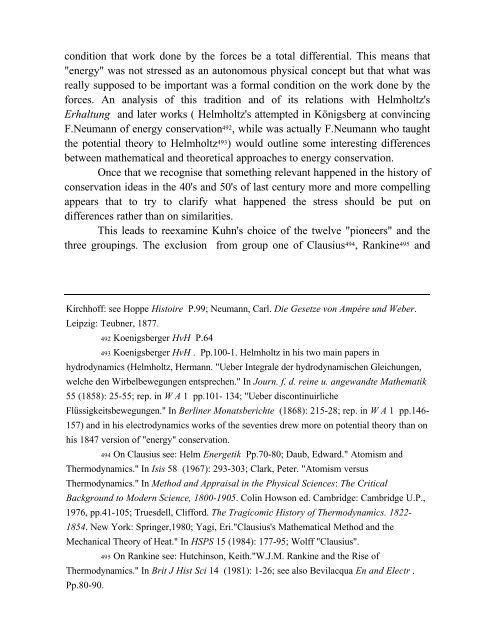Conservation and Innovation : Helmholtz's Struggle with Energy ...
Conservation and Innovation : Helmholtz's Struggle with Energy ...
Conservation and Innovation : Helmholtz's Struggle with Energy ...
You also want an ePaper? Increase the reach of your titles
YUMPU automatically turns print PDFs into web optimized ePapers that Google loves.
condition that work done by the forces be a total differential. This means that<br />
"energy" was not stressed as an autonomous physical concept but that what was<br />
really supposed to be important was a formal condition on the work done by the<br />
forces. An analysis of this tradition <strong>and</strong> of its relations <strong>with</strong> <strong>Helmholtz's</strong><br />
Erhaltung <strong>and</strong> later works ( <strong>Helmholtz's</strong> attempted in Königsberg at convincing<br />
F.Neumann of energy conservation 492, while was actually F.Neumann who taught<br />
the potential theory to Helmholtz 493) would outline some interesting differences<br />
between mathematical <strong>and</strong> theoretical approaches to energy conservation.<br />
Once that we recognise that something relevant happened in the history of<br />
conservation ideas in the 40's <strong>and</strong> 50's of last century more <strong>and</strong> more compelling<br />
appears that to try to clarify what happened the stress should be put on<br />
differences rather than on similarities.<br />
This leads to reexamine Kuhn's choice of the twelve "pioneers" <strong>and</strong> the<br />
three groupings. The exclusion from group one of Clausius 494, Rankine 495 <strong>and</strong><br />
Kirchhoff: see Hoppe Histoire P.99; Neumann, Carl. Die Gesetze von Ampére und Weber.<br />
Leipzig: Teubner, 1877.<br />
492 Koenigsberger HvH P.64<br />
493 Koenigsberger HvH . Pp.100-1. Helmholtz in his two main papers in<br />
hydrodynamics (Helmholtz, Hermann. "Ueber Integrale der hydrodynamischen Gleichungen,<br />
welche den Wirbelbewegungen entsprechen." In Journ. f. d. reine u. angew<strong>and</strong>te Mathematik<br />
55 (1858): 25-55; rep. in W A 1 pp.101- 134; "Ueber discontinuirliche<br />
Flüssigkeitsbewegungen." In Berliner Monatsberichte (1868): 215-28; rep. in W A 1 pp.146-<br />
157) <strong>and</strong> in his electrodynamics works of the seventies drew more on potential theory than on<br />
his 1847 version of "energy" conservation.<br />
494 On Clausius see: Helm Energetik Pp.70-80; Daub, Edward." Atomism <strong>and</strong><br />
Thermodynamics." In Isis 58 (1967): 293-303; Clark, Peter. "Atomism versus<br />
Thermodynamics." In Method <strong>and</strong> Appraisal in the Physical Sciences: The Critical<br />
Background to Modern Science, 1800-1905. Colin Howson ed. Cambridge: Cambridge U.P.,<br />
1976, pp.41-105; Truesdell, Clifford. The Tragicomic History of Thermodynamics. 1822-<br />
1854. New York: Springer,1980; Yagi, Eri."Clausius's Mathematical Method <strong>and</strong> the<br />
Mechanical Theory of Heat." In HSPS 15 (1984): 177-95; Wolff "Clausius".<br />
495 On Rankine see: Hutchinson, Keith."W.J.M. Rankine <strong>and</strong> the Rise of<br />
Thermodynamics." In Brit J Hist Sci 14 (1981): 1-26; see also Bevilacqua En <strong>and</strong> Electr .<br />
Pp.80-90.
















